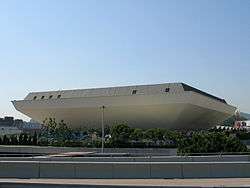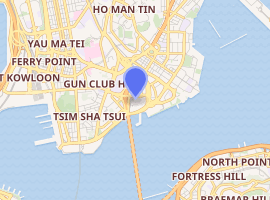Hong Kong Coliseum
Hong Kong Coliseum, commonly known as the Hung Hom Coliseum, is a multi-purpose indoor arena, in Hung Hom Bay, Kowloon, Hong Kong. It is in Yau Tsim Mong District.[1]
| Hong Kong Coliseum | |
|---|---|
 Hong Kong Coliseum (2008) | |

| |
| Alternative names | Hung Hom Coliseum |
| General information | |
| Architectural style | Minimalism |
| Address | 9 Cheong Wan Road |
| Town or city | Hung Hom Bay, Kowloon |
| Country | |
| Coordinates | 22°18′5.33″N 114°10′55.23″E |
| Construction started | March 1973 |
| Completed | August 1981 |
| Inaugurated | 27 April 1983 |
| Renovated | 2008 |
| Cost | HK$ 140 000 000 HK$ 160 000 000 (2008 renovation) |
| Client | Urban Council |
| Management | Leisure and Cultural Service Department |
| Technical details | |
| Structural system | reinforced concrete |
| Design and construction | |
| Main contractor | Urban Council |
| Other information | |
| Seating capacity | 12,500 |
| Hong Kong Coliseum | |||||||||||||||
|---|---|---|---|---|---|---|---|---|---|---|---|---|---|---|---|
 Inside the Hong Kong Coliseum, during the FIVB World Grand Prix | |||||||||||||||
| Traditional Chinese | 香港體育館 | ||||||||||||||
| Simplified Chinese | 香港体育馆 | ||||||||||||||
| Cantonese Yale | Hēunggóng Táiyuhkgún | ||||||||||||||
| |||||||||||||||
| Hung Hom Coliseum | |||||||||||||||
| Traditional Chinese | 紅磡體育館 | ||||||||||||||
| Simplified Chinese | 红磡体育馆 | ||||||||||||||
| Cantonese Yale | Hùhngham Táiyuhkgún | ||||||||||||||
| |||||||||||||||
| Second alternative Chinese name | |||||||||||||||
| Traditional Chinese | 紅館 | ||||||||||||||
| Simplified Chinese | 红馆 | ||||||||||||||
| Cantonese Yale | Hùhnggún | ||||||||||||||
| |||||||||||||||
It was built by the Urban Council and inaugurated on 27 April 1983. The opening of the stadium coincided with the 100th anniversary of the Urban Council. [2] The coliseum has 12,500 seats, which is the second largest among indoor facilities in Hong Kong, only behind the 2005-opened AsiaWorld–Arena.
It is now managed by the Leisure and Cultural Service Department of the Hong Kong Government.
Facilities
The Hong Kong Coliseum consists of a big arena and a number of conference rooms.
Arena
.jpg)
The arena is rectangular with sides 41m each, with a concrete cement flooring.
During performances, the floor may be covered with different overmounted floorings, such as demountable wooden flooring or various rubberized roll-outs, to facilitate the set-up of sporting equipment and the playing of different sporting activities such as futsal, badminton, basketball, volleyball and ice-skating.
Moreover, the floor can hold strong pressures up to 1,800 kg/m2, which cannot even be done by industrial buildings. This facilitates the set up of stages, platforms and sound equipments during concerts and other concert-like performances that requires an elevated stage and good PA systems.
Different technical equipments and a 4-side colour television projection system are also present to project the performer's image onto a screen, so that audience sitting around the rear side of the stadium can also see clearly.
Conference Rooms
The Hong Kong Coliseum offers both open and sheltered areas for holding conventions and conferences. The demountable open stage provides the arena with an excellent forum for public assemblies as well as staging live television broadcasts of opening ceremonies.
Reception Room
The reception room acts as an assistant facility for hirers of the arena and the conference rooms to accommodate visiting VIPs. The room can hold 60 persons.
Events
Even though its formal name in Chinese roughly translates to "Sports Arena", the venue often serves as a concert venue for popular singers. In addition, some universities rent it every year for congregation. Some performances like ice-skating also choose Hong Kong Coliseum as their stages. It was also used every year from 1991 to 2010 to hold the Miss Hong Kong Pageant, except for 2008.
It also hosts a part of the FIVB Volleyball Women's Nations League (before: FIVB World Grand Prix) for volleyball every year.
On 3 June 2001, Irish vocal pop band Westlife held a concert for their Where Dreams Come True Tour supporting their album Coast to Coast.
Venue for 2009 East Asian Games
The Hong Kong Coliseum was one of the venues for the 5th East Asian Games that was hosted in Hong Kong in 2009.
See also
References
- "Yau Tsim Mong District" (PDF). Electoral Affairs Commission. Retrieved 2019-08-30.
- Wood, Chris (2018-04-26). "Why the Hong Kong Coliseum was built – to avoid embarrassment". South China Morning Post. Retrieved 2019-10-15.
External links
![]()
| Events and tenants | ||
|---|---|---|
| Preceded by Rotterdam Ahoy Sportpaleis Rotterdam |
FIFA Futsal World Championship Final Venue 1992 |
Succeeded by Palau Sant Jordi Barcelona |